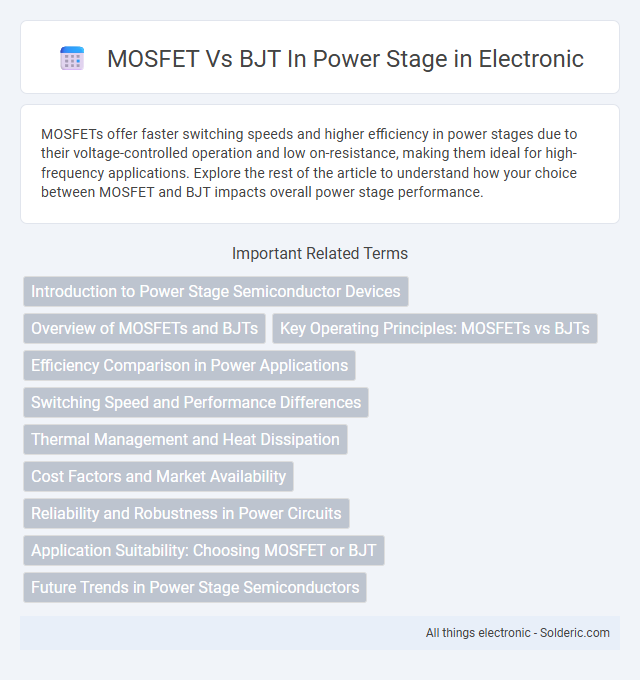MOSFETs offer faster switching speeds and higher efficiency in power stages due to their voltage-controlled operation and low on-resistance, making them ideal for high-frequency applications. Explore the rest of the article to understand how your choice between MOSFET and BJT impacts overall power stage performance.
Comparison Table
| Parameter | MOSFET | BJT |
|---|---|---|
| Switching Speed | High switching speed, ideal for high-frequency applications | Lower switching speed, less efficient at high frequencies |
| Control Method | Voltage-controlled device | Current-controlled device |
| Input Impedance | Very high input impedance, low gate current | Lower input impedance, requires base current |
| On-state Resistance / Voltage Drop | Low on-state resistance (R_DS(on)), lower conduction losses | Higher voltage drop across collector-emitter, higher conduction losses |
| Thermal Stability | Better thermal stability, positive temperature coefficient | Less thermally stable, risk of thermal runaway |
| Power Efficiency | Higher efficiency in power stages, preferred in power electronics | Lower efficiency, used in low-frequency or linear applications |
| Drive Complexity | Simpler drive requirements (voltage drive) | Complex drive circuit needed to supply base current |
| Cost | Generally higher cost for power MOSFETs | Usually lower cost for BJTs |
Introduction to Power Stage Semiconductor Devices
Power stage semiconductor devices primarily consist of MOSFETs and BJTs, each offering distinct advantages in switching efficiency and current handling. MOSFETs excel in high-speed switching with low gate drive power due to their voltage-driven operation, making them ideal for high-frequency applications. BJTs provide superior current density and robustness in high-voltage environments but require continuous base current, influencing thermal management and overall efficiency.
Overview of MOSFETs and BJTs
MOSFETs (Metal-Oxide-Semiconductor Field-Effect Transistors) operate as voltage-controlled devices offering high input impedance and fast switching speeds, making them ideal for efficient power stage applications. BJTs (Bipolar Junction Transistors) are current-controlled devices with lower input impedance and slower switching compared to MOSFETs, but they provide high current gain, which benefits certain power amplification tasks. Understanding the distinct electrical characteristics and operational efficiencies of MOSFETs and BJTs helps optimize Your choice for specific power stage designs.
Key Operating Principles: MOSFETs vs BJTs
MOSFETs operate as voltage-controlled devices utilizing an insulated gate to modulate conductivity, enabling fast switching and high input impedance in power stages. BJTs function as current-controlled devices relying on base current to regulate collector-emitter conduction, often resulting in higher gain but increased drive power requirements. The voltage-driven gate in MOSFETs leads to lower switching losses and improved efficiency compared to the current-driven operation of BJTs.
Efficiency Comparison in Power Applications
MOSFETs generally offer higher efficiency than BJTs in power stage applications due to their lower on-resistance (R_DS(on)) and faster switching speeds, which reduce conduction and switching losses. BJTs may suffer from higher voltage drops and slower switching, leading to increased power dissipation and reduced efficiency in high-frequency circuits. Your choice of device impacts overall power efficiency, with MOSFETs typically preferred for modern, high-efficiency power converters.
Switching Speed and Performance Differences
MOSFETs exhibit faster switching speeds compared to BJTs due to their majority carrier conduction, which reduces charge storage and switching losses. This results in higher efficiency and better performance in high-frequency power stages, making MOSFETs ideal for applications such as DC-DC converters and motor drives. BJTs, while capable of handling higher current densities, often suffer from slower switching times and increased power dissipation under rapid switching conditions.
Thermal Management and Heat Dissipation
MOSFETs typically offer lower on-resistance (R_DS(on)) than BJTs, resulting in reduced conduction losses and improved thermal efficiency in power stages. Their inherent switching characteristics generate less heat during rapid transitions, easing heat dissipation and simplifying thermal management strategies. Your power stage design benefits from MOSFETs' superior thermal performance, enabling smaller heatsinks and more compact cooling solutions compared to BJTs.
Cost Factors and Market Availability
MOSFETs generally incur higher initial costs than BJTs due to their advanced manufacturing processes, but their superior efficiency and lower heat dissipation often reduce overall system expenses. BJTs benefit from a mature production infrastructure, ensuring widespread availability and lower prices, especially in designs requiring rugged, high-current handling. Market trends indicate increasing MOSFET adoption driven by demand for high-frequency and low-voltage power stages, whereas BJTs remain preferred in cost-sensitive, high-power applications.
Reliability and Robustness in Power Circuits
MOSFETs exhibit higher reliability and robustness in power stages due to their superior thermal stability, faster switching speeds, and inherent gate oxide insulation, which reduces susceptibility to thermal runaway and latch-up compared to BJTs. BJTs are more prone to secondary breakdown and require careful current control to avoid thermal stress, limiting their robustness under high-power conditions. MOSFETs' efficient low on-resistance and voltage-driven operation enhance their durability in harsh environments, making them preferable for modern power circuits requiring high reliability.
Application Suitability: Choosing MOSFET or BJT
MOSFETs excel in high-frequency switching applications due to their fast switching speed and high input impedance, making them ideal for modern power stages in switching regulators and DC-DC converters. BJTs offer better performance in low-frequency, high-current environments because of their superior current gain and robustness under heavy load conditions. Your choice between MOSFET and BJT depends on the specific power stage requirements, including switching frequency, efficiency, and thermal management constraints.
Future Trends in Power Stage Semiconductors
Future trends in power stage semiconductors highlight the growing preference for MOSFETs over BJTs due to their superior switching speed, lower on-resistance, and better thermal performance, which enhance energy efficiency in modern applications. Innovations in wide bandgap materials like GaN and SiC are further pushing MOSFET capabilities, offering higher voltage operation and reduced losses compared to traditional silicon BJTs. Your designs will increasingly benefit from these advancements, enabling more compact, reliable, and efficient power stages in next-generation electronic devices.
MOSFET vs BJT in power stage Infographic

 solderic.com
solderic.com